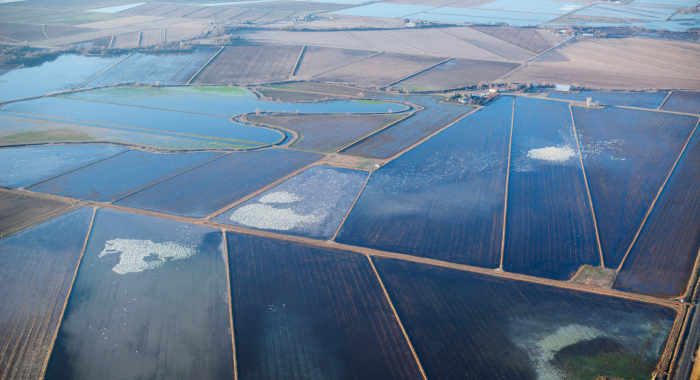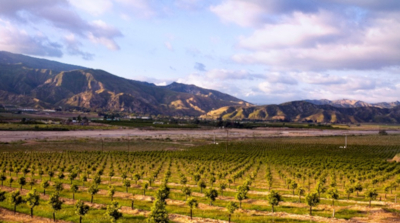How do we put economics and finance to work for conservation?

Aerial view of flooded rice fields in California's Sacramento Valley where TNC applied a new economic approach to provide habitat for over 1 million migrating shorebirds. Photo: © Drew Kelly
In a world increasingly altered by human activity, the natural systems we depend on are fraying. We are entering a critical decade in which climate change will decide the fate of our planet. We know that when we protect nature, nature protects us, and we now have the opportunity to restore natural systems in ways that meet 21st century needs. The Nature Conservancy has protected over 1.2 million acres in California and tens of millions of acres worldwide. This is an impressive accomplishment, but it only represents a fraction of the natural areas people and nature rely on around the world. It is time to tap the potential of markets to align economic and environmental interests so that we can protect nature on a global scale.
We make the business case for conservation by illustrating the costs of building in areas at high risk of catastrophic wildfire, or the savings to solar developers when they site projects on lands with low biodiversity.
We design new conservation incentives in the form of payments to farmers who adopt conservation-friendly practices such as groundwater recharge and metering, or groundwater markets that sustain agriculture and keep suburban sprawl at bay.
We bring private capital to the table with insurance payouts that fund reef and wetland restoration to protect our coastlines and low-interest loans that make our grant funding go farther so that we can protect more land in Ventura County and the Lassen Foothills.
We have an opportunity to apply the principles of economics and finance to demonstrate the value of conservation and create systems that incentivize the protection of nature at scale. In a changing climate, natural landscapes are extremely valuable for the benefits they provide to both people and nature.
The goal of MarketLab is to harness the power of markets to drive game-changing investment in conservation by showing stakeholders what nature is really worth. This concept is relatively new, but from BirdReturns to the Fox Canyon Groundwater Market, the examples we have developed have been powerful and promising. Now, it is time to let that work do what markets do best: grow.
We start with a conservation problem:
Migratory birds have nowhere to land in California’s Central Valley, but the cost of buying enough habitat in the region is too high.
Then a small team with specialized skills in economics and finance works to develop interventions that will move the needle:
Design an incentive program that pays Central Valley rice farmers to flood their fields at the exact times migratory birds need to stop and rest.
As of today, our BirdReturns Program has provided temporary habitat for over one million migrating birds at a fraction of the cost of buying the land. Our goal is to fit the market-based solution to the conservation problem with interventions that include compelling economic analyses and the development of new funding structures that benefit nature.

Farmer Doug Thomas holds rice at a storage facility near Olivehurst, California. Photo: © Drew Kelly
We work with an influential network of partners to amplify our efforts. Leading economists at universities and think tanks help us demonstrate the value of conservation and craft effective incentives. The benefit is mutual because we have something academics need: a real-world application for their theories. Together, with our partners, we use publications and real-world examples to drive policy change and enable markets for nature’s benefit.
With the creation of the first groundwater market under California’s new sustainable groundwater law, we demonstrated a model that can be replicated across the state to benefit both agriculture and nature.On the implementation side, investors, project developers, and other market actors help us create new financial structures and products that generate both environmental and financial returns.
MarketLab is already a hub of economic ingenuity in California, and our goal is for that influence to make way for a global network of collaborators across fields whose innovation and analysis can address some of the world’s most pressing conservation challenges.
TNC is the largest environmental organization in the world, with a 68-year track record of successfully piloting creative conservation solutions. TNC’s mission is to protect the lands and waters on which all life depends; that mission demands that we deploy solutions at a scale equal to the environmental challenges of the 21st century. By aligning economic and environmental interests, MarketLab demonstrates that protecting nature is not altruism, it is good business.
MarketLab sits in TNC’s California chapter, the largest chapter in the organization. California is MarketLab’s “laboratory” but we are working to make sure our impact spans the globe.
Groundwater markets represent a flexible tool for achieving aquifer resilience while benefiting farmers and other groundwater users. TNC is piloting the first groundwater market under California’s Sustainable Groundwater Management Act. TNC has entered into phase two of the Fox Canyon pilot groundwater market in Ventura County, where groundwater users will be able to trade water to stay afloat while complying with steep cuts to water use.
The water market benefits both people and nature by preserving one of the country’s most productive agricultural regions on the outskirts of the Los Angeles metro area, where development pressure is strong. These agricultural lands provide an important buffer for habitat and create opportunities for groundwater recharge and storage that are not possible on developed lands. Through this pilot, TNC will demonstrate how a groundwater market can help achieve basin sustainability and create a model that can be replicated by over 250 groundwater management agencies across the state. [View infographic and related publications]

TNC has ensured accurate measurement of agricultural pumping as part of the Fox Canyon groundwater market. | © Sarah Heard/TNC
Select Coverage:
Caps on Groundwater Use Create a New Market in California
The Economist
Ventura Farmers Take Charge, Designing First-of-Its-Kind Groundwater Market
Farm Credit West Spotlight
The Water Marketplace
The Indicator from Planet Money
The Fox Canyon Water Market: A Market-Based Tool for Groundwater Conservation Goes Live
U.S. Department of Agriculture

Agricultural field along Santa Clara River, CA. | © Melinda Kelley
In California and across the Western United States, working farms and ranches often form an effective buffer between the pressure of intense urban development and conservation-rich wilderness areas. In many cases, keeping working lands in production is compatible with conservation goals, and doing so can unlock financing for acquisitions. This increases the impact of public and philanthropic dollars by increasing the total funding available for acquisitions.
MarketLab is building out the use of repeatable, scalable, impact-first financing for the acquisition and protection of working lands. Having piloted this approach to acquire a farm along Southern California’s last free-flowing river, the Santa Clara, we are now applying this approach more broadly, from the Lassen Foothills to the South Coast.
TNC is investigating opportunities for insurance and innovative finance to promote investment in natural infrastructure such as wetlands, to reduce the risk of climate-exacerbated flooding around the San Francisco Bay. This issue is particularly acute in the heart of Silicon Valley. TNC is partnering with the California Department of Insurance, Swiss RE (a global reinsurance company), San Mateo County, and other stakeholders, to create an entirely new asset class around insuring nature.
This work builds on TNC’s role in the creation of a new insurance policy for the Mesoamerican Reef, which protects Mexico’s Yucatan tourism industry from the impacts of hurricanes. Our collaboration in California promises to expand the use of natural infrastructure to protect people and the built environment at a time when our state faces more and more severe disasters.

A flock of marbled godwits in SF Bay, CA | © Rebecca Wells/TNC
Select Coverage:
Parametric Insurance Policy to Cover Coral Reef
Business Insurance
Insuring Nature to Ensure a Resilient Future
The Nature Conservancy website, nature.org

Workers clean solar panels for maximum efficiency at the power solar facility in Lancaster, CA | © Dave Lauridsen
Select Coverage:
Power of Place: Advancing a Clean Energy Future
The Nature Conservancy website, nature.org
CA Farmers are Planting Solar Panels as Water Supplies Dry Up
The Los Angeles Times
In 2018, California lawmakers set an ambitious climate goal: 100% clean electricity by 2045. While this is a great sign for climate mitigation, it could also result in major impacts to natural habitat, especially given that California may need between 1.6 and 3.1 million acres of wind and solar by 2050. TNC has developed a method for integrating nature into energy planning, showing that it is possible to meet California’s future renewable energy needs, while minimizing impacts to the environment.
In a recent study, we showed that this approach is not only feasible, it is good for business. Our analysis found that siting utility-scale solar projects in areas of high biodiversity increases total project costs by up to 15% relative to low biodiversity areas, due to higher habitat mitigation requirements. When applied to California’s interim target of 50% clean energy, siting solar projects on low biodiversity lands could collectively save developers $350 million. [View related publications]
Sarah Heard, E.J. Remson, Matthew Fienup, Siobhan King
In 2014, California passed the Sustainable Groundwater Management Act (SGMA) which regulates groundwater at scale for the first time, requiring the state’s largest source of stored water to be…Sarah Heard, E.J. Remson, Siobhan King, Sandi Matsumoto
The Conservancy has a vested interest in preserving farms in Ventura County because they buffer important river and wetland habitat from nearby urban lands. In western Ventura County, over…Justine E. Hausheer, Mark D. Reynolds, Greg Golet
Eric Hallstein, Matt Miller